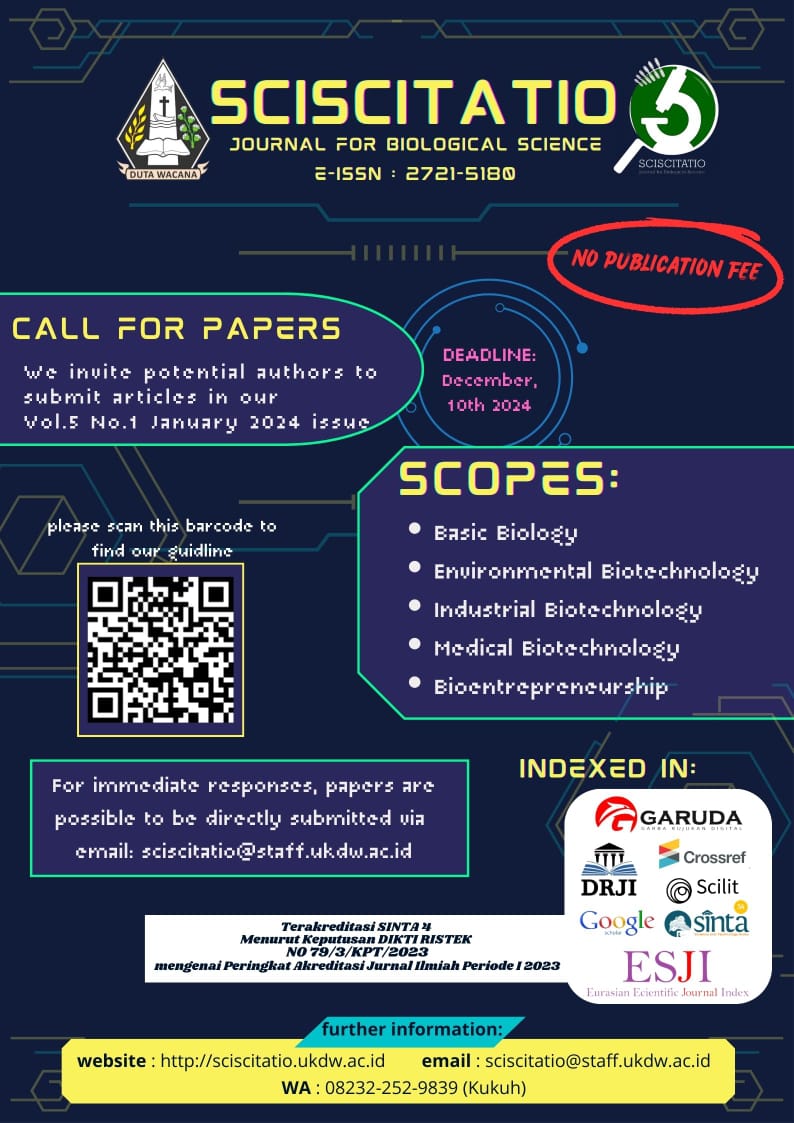Isolasi, Skrining dan Identifikasi Fungi Selulolitik Asal Tempat Pengolahan Sampah Terpadu (TPST) Rempoah, Kabupaten Banyumas
DOI:
https://doi.org/10.21460/sciscitatio.2024.52.175Keywords:
fungi selulotik, identifikasi, isolasi, TPST RempoahAbstract
Tempat Pengolahan Sampah Terpadu (TPST) Rempoah, Kabupaten Banyumas memiliki timbunan sampah organik melimpah yang dikomposkan secara alami. Sampah organik dapat terdegradasi secara alami oleh beberapa mikroba, salah satunya adalah fungi selulolitik yang dapat mendegradasi selulosa dengan mekanisme enzimatis. Salah satu upaya untuk mengatasi permasalahan sampah organik yang melimpah adalah mengeksplorasi mikroba yang memiliki potensi dalam menguraikan sampah organik dengan efektif dan cepat. Tujuan dari penelitian ini adalah untuk memperoleh isolat fungi yang memiliki potensi selulolitik asal TPST Rempoah. Penelitian ini terdiri dari tahap pengambilan sampel; isolasi dan pemurnian fungi; skrining fungi selulolitik dengan menggunakan media CMC; dan identifikasi isolat fungi secara morfologi. Hasil penelitian didapatkan 6 isolat fungi selulolitik yang berasal dari Genus Aspergillus yang berhasil diisolasi dari TPST Rempoah. Nilai indeks selulolitik tertinggi dimiliki isolat Aspergillus RB1 dengan nilai IS sebesar 1,33.
References
Agustinur, A., & Yusrizal, Y. (2021). Eksplorasi Jamur Asal Tongkol Kosong Kelapa Sawit yang Berpotensi Sebagai Agen Pendegradasi Selulosa. Jurnal Agrotek Tropika, 9(3): 533-541.
Barapatre, S., Rastogi, M., Savita & Nandal, M. (2020). Isolation of Fungi and Optimization of pH and Temperature for Cellulase Production. Nature Environment and Pollution Technology, 19(4): 1729-1735.
Dina, F., Hutajulu, E., Hazimah, H., Pardi, H., Silitonga, F., & Ramadhani, E. (2023). Isolation and Morphological Identification of Cellulolytic Fungi from Domestic Waste in South Toapaya Village, Bintan Regency. BIO Web of Conferences. 79. 12002. 10.1051/ bioconf/20237912002.
Emmanuel, U., Iroha I., Ejikeugwu C., Onochie C., Nwachi C. (2017). Isolation and Characterization of Bacteria and Fungi Associated With Biodegradation of Municipal Solid Wastes in Abakaliki Metropolis, Nigeria. International Journal of Environment, Agriculture and Biotechnology, 2(3): 1294-1304.
Gautam, S. P., Bundela, P. S., Pandey, A. K., Jamaluddin, Awasthi, M. K., & Sarsaiya, S. (2012). Diversity of cellulolytic microbes and the biodegradation of municipal solid waste by a potential strain. International journal of microbiology, 325907
Haqq, I. M., Dewi, R. S., Mumpuni, A., Hikam, A. R. & Yulianti, D. W. (2022). Identifikasi dan Uji Potensi Amilolitik Isolat Jamur Pendegradasi Sampah Organik. Bioeksakta: Jurnal Ilmiah Biologi Unsoed, 4(1): 19-27.
Hasanah, N., & Iwan, S. (2015). Aktivitas selulase isolat jamur isolat jamur dari limbah media tanam jamur merang. Prosiding Seminar Nasional Masyarakat Biodiversitas Indonesia, 1(5): 1110-1115.
Hidayat, R. A., & Isnawati, I. (2021). Isolasi dan Karakterisasi Jamur Selulolitik pada Fermetodege: Pakan Fermentasi
Berbahan Campuran Eceng Gondok, Bekatul Padi, dan Tongkol Jagung. Lentera Bio, 10(2): 176-187.
Hikam, A., Yulianti, D., & Ginanjar, R. (2021). Diversitas dan Potensi Jamur Lignolitik Asal Seresah Daun. Al-Hayat: Journal
of Biology and Applied Biology, 4(1): 33-42
Idiawati, N., Harfinda, E. M. & Arianie, L. (2014). Produksi Enzim Selulase oleh Aspergillus niger pada Ampas Sagu. Jurnal Natur Indonesia, 16(1): 1-9.
Jane E. S, and Shelley C. R. (2014). Isolation and Identification of Fungi. In Jane E. S. (eds), Canine and Feline Infectious Diseases, W. B. Saunders, Philadelphia, pp. 29-36.
Jufri, R. (2020). Microbial isolation. Journal La Lifesci, 1(1): 18-23.
Karima, R., Rukmi, M. G. I. & Kusumaningrum, H. P. (2020). Aktivitas Enzim dan Identifikasi Fenotipik Isolat Kapang Aspergillus Kelompok Flavi Dari DUCC (Diponegoro University Culture Collections). Bioma, 22(1): 1-7.
Kementerian Lingkungan Hidup dan Kehutanan. (2024). Capaian Kinerja Pengelolaan Sampah. Diakses pada 9 Mei 2024, dari https://sipsn.menlhk. go.id
Legodi, L. M. La Grange, D, van Rensburg, E.L.J., Ncube, I. (2019). Isolation of Cellulose Degrading Fungi from Decaying Banana Pseudostem and Sterilitzia alba. Enzyme Res: 1-10.
Nji, Q. N., Babalola, O. O., Mwanza, M. (2023). Soil Aspergillus Species, Phatogenicity and Control Pespectives. J. Fungi,
(7):766.
Nofu, K., Khotimah, S., & Lovadi, I. (2014). Isolasi dan Karakteristik Bakteri Pendegradasi Selulosa pada Ampas Tebu Kuning. Jurnal Protobiont, 3(1): 25-33.
Pitt, J. I. & Hocking, A. D. (2009). Fungi and Food Spoilage. New York: Springer.
Purwanto, A. (2020). Isolasi Jamur Selulolitik Trichoderma pada Beberapa Limbah Organik. Jurnal Agri-Tek: Jurnal Penelitian Ilmu-Ilmu Eksakta, 21(1): 42-47.
Sivaramanan, S. & Samaraweera, P. (2014). Isolation of Cellulolytic Fungi and their Degradation on Cellulosic Agricultural Wastes. Journal of Academia and Industrial Research, 2(8): 458-463.
Sutari, N. W. S. (2020). Isolasi dan Identifikasi Morfologi Jamur Selulolitik dari Limbah Rumah Tangga di Desa Sanur Kauh, Bali. Agrovigor: Jurnal Agroteknologi, 13(2): 100-105.
Talantan, V. M., Marina, M., Lambui, O. & Suwastika, I. N. (2018). Uji Aktivitas Selulase dari Jamur Selulolitik Asal Tanah Danau Kalimpa’a Sulawesi Tengah. Natural Science: Journal of Science and Technology, 7(3): 323-333.
Watanabe, T., (2002). Pictorial Atlas of Soil and Seed Fungi. London: CRC Press.
Wieland, G., Neumann, R., & Backhaus, H. (2001). Variation of microbial communities in soil, rhizosphere, and rhizoplane in response to crop species, soil type, and crop development. Applied and environmental microbiology, 67(12): 5849-5854.
Downloads
Published
How to Cite
Issue
Section
License
Copyright (c) 2024 THE AUTHOR(S)

This work is licensed under a Creative Commons Attribution-ShareAlike 4.0 International License.

